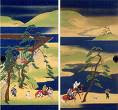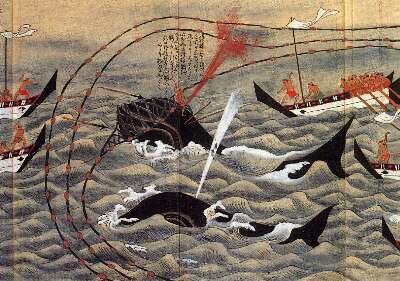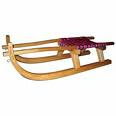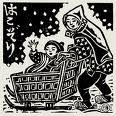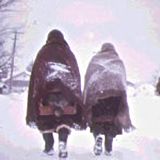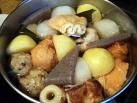::::::::::::::::::::::::::::::::::::::::::::::::::::::::::::::::::::::::::::::::::::::::::::::::::::
Ice cutting (koori kiru)
***** Location: Japan
***** Season: Late Winter
***** Category: Humanity
*****************************
Explanation
Cutting ice from a clear lake and putting it into a storehouse (muro) to keep it for summer was vital during the times without electricity and refrigerators.
Lakes with especially clear water were protected and a Shinto shrine was usually close by to pray for the safe clear ice to send to the local lord or Shogun in Edo during the Summer Months.
:::::::::::::::::::::::::::::::::::::::::::::::::::::::::::::::::::::::::::::::::::::::::::::::::::
koori kiru 氷切る(こおりきる)cutting ice
... saihyoo 採氷 (さいひょう)
koori hiku 氷挽く(こおりひく)cutting ice
saihyoojoo 採氷場(さいひょうじょう)place for cutting ice
saihyoofu 採氷夫(さいひょうふ)worker who cuts ice
saihyoosha 採氷車(さいひょうしゃ)cart to transport the cut ice
saihyoochi 採氷池(さいひょうち)pond/lake for cutting ice
:::::::::::::::::::::::::::::::::::::::::::::::::::::::::::::::::::::::::::::::::::::::::::::::::::
saihyoosen 砕氷船 (さいひょうせん) icebreaker ship
Eisbrecher
:::::::::::::::::::::::::::::::::::::::::::::::::::::::::::::::::::::::::::::::::::::::::::::::::::::
kigo for early winter
hio no tsukai 氷魚の使 (ひおのつかい) "bringer of iced fish"
hio o tamau 氷魚を賜う(ひおをたまう)
mootoo no jun 孟冬の旬 (もうとうのじゅん)
In the Heian period, it was custom to bring frozen fish from Yamashiro no Kuni (Uji) 山城国宇治 and Omi (Ueda) 近江国田上 to the court in Kyoto.
:::::::::::::::::::::::::::::::::::::::::::::::::::::::::::::::::::::::::::::::::::::::::::::::::::
:::::::::::::::::::::::::::::::::::::::::::::::::::::::::::::::::::::::::::::::::::::::::::::::::::
Eating ice during other seasons !
kigo for late summer
himuro 氷室 (ひむろ) icehouse, ice cellar
himuro mori 氷室守(ひむろもり)warden of the ice cellar
himuro no yuki 氷室の雪(ひむろのゆき)snow in the ice cellar
himuro no yama 氷室の山(ひむろのやま) mountain with an ice cellar
The himuro was often in the forest, close to the pond where the ice was cut. It had to be a cold and shaded place.
himuro no sakura 氷室の桜 (ひむろのさくら)
cherry blossoms in the ice cellar
..... himuro no hana 氷室の花(ひむろのはな)
observances in late summer
koori o kuuzu 氷を供ず (こおりをくうず) offering ice (in a Shinto shrine)
... hi n omitsugi 氷の貢(ひのみつぎ)
himuro no tsukai 氷室の使(ひむろのつかい)bringer of the ice
hi no omono 氷の御物(ひのおもの)ice offering
... shihyoo no setsu 賜氷の節 (しひょうのせつ)
first day of the sixth months
himochi o iwau 氷餅を祝う (ひもちをいわう) celebrate with iced mochi (see below, minazuki sweets)
himuro no sekku 氷室の節供(ひむろのせっく)seasonal celebration of the ice cellars
koori n o tsuitachi 氷の朔日(こおりのついたち)"first day of the ice"

himuro no sakura 氷室の桜 (ひむろのさくら) "cherry blossoms in ice"
himuro no hana 氷室の花(ひむろのはな) "flowers in ice"
offering from the fish of the sea and fish of the land (sweetwater fish) at Shrine Himuro Jinja, Nara 奈良氷室神社
. WASHOKU
Food treasures of the sea and the mountains

sweet called "himuro no sakura" cherry in the ice cellar
:::::::::::::::::::::::::::::::::::::::::::::::::::::::::::::::::::::::::::::::::::::::::::::::::::::
kigo for all summer
koori reizooko 氷冷蔵庫(こおりれいぞうこ)
refrigerator (with ice)
The oldfashioned ones used blocks of ice.
. . . CLICK here for Photos !
reizooko 冷蔵庫 (れいぞうこ) refrigerator
denki reizooko 電気冷蔵庫(でんきれいぞうこ)electric refrigarator
gasu reizooko ガス冷蔵庫(がすれいぞうこ) gas refrigerator
Kühlschrank, Eisschrank
koori uri 氷売 (こおりうり) seller of ice blocks
. koorimizu uri 氷水売り vendors of "ice water" . in Edo
. hanagoori 花氷 (はなごおり) "ice flowers"
kooribashira 氷柱(こおりばしら) ice pillar
"summer ice" . natsugoori 夏氷(なつごおり)
kakigoori かき氷(かきごおり), shaved ice with flavor topping
. WASHOKU
Drinks with ice in Summer
. Ice cream, ice-cream, icecream (aisu)
.SAIJIKI ... HUMANITY
Kigo for Summer
:::::::::::::::::::::::::::::::::::::::::::::::::::::::::::::::::::::::::::::::::::::::::::::::::::::
observance kigo for the New Year
Kamakura かまくら "snow hut"
..... 雪室 (ゆきむろ) yukimuro
Festival for children in Akita on January 15.
In the town of Yokote, on February 15 and 16.

Children make mountains of snow, about 2 meters high and carve an opening, where they can sit inside by candlelight and enjoy special food. The grown-ups come visiting and children offer them mochi ricecakes and sweet sake.
It is a ritual to ward off evil insects and birds from the rice paddies and pray for a good harvest (torioi 鳥追い).
Yukimuro are often carved in the natural snow mountains of the region.

Stamp in memory of this festival
SAIJIKI – NEW YEAR OBSERVANCES
*****************************
Worldwide use
*****************************
Things found on the way
himuro manjuu 氷室饅頭 "ice cellar manjuu"


Eaten on the first day of the 7th month (himuro no tsuitachi)
They are of white and red color and eaten with the wish for good health during the following year. Made from barley flower. In Kaga it was custom to open the ice cellars (himuro) on the first day of the 6th month (now June 30). The ice, which was collected in winter from pure water ponds, was put on carts and transported hastily to the Shogun in Edo.
. WASHOKU
氷室饅頭 himuro "ice cellar manjuu"
:::::::::::::::::::::::::::::::::::::::::::::::::::::::::::::::::::::::::::::::::::::::::::::::::::::
. WASHOKU
minazuki 水無月 (みなずき) sweets for June
These sweets were the poor man's equivalent of a royal treat in June, when the emperor in Kyoto was served beans on shaved ice that was taken into a storeroom in the winter time.
The ice stores (himuro 氷室) for the emperor's court were in the north of Kyoto, protected by the shrine Himuro Jinja 氷室神社 in Kitayama.
:::::::::::::::::::::::::::::::::::::::::::::::::::::::::::::::::::::::::::::::::::::::::::::::::::::::
Himuro Yakushidoo 氷室薬師堂 Himuro Yakushido
- quote
Himuro Yakushi, or formally named Murakamiji Temple, is a historic temple founded by Sakanoue Tamuramaro in 807 to pray for safety of his soldiers. The temple has been worshipped by local people for its divine power to bring national safety and people’s happiness.
Yakushi Nyorai at this temple is especially famous for curing eye diseases. Votive tablets, on which faces with big black round eyes are drawn, are hung at the side of the Yakushi Hall. Also, many pieces of paper, on which pictures of eyes are drawn, are dedicated and hung inside the hall. You will feel strong religious faith dedicated to the temple from these votive articles.
There is an interesting legend about this temple.
Once upon a time, there lived an extremely cowardly warrior in a nearby village. He wanted to cure his cowardice and visited the temple on 100 consecutive nights. On the 100th night, a specter appeared in front him. Then he gathered his courage and struck at it with his sword only to find that it was a pillar of the hall. Visitor can see the scar made by him even today.
It’s a heart-easing story for a temple with such a solemn atmosphere, isn’t it?
source : nippon-kichi.jp
*****************************
HAIKU

source : itoyo/basho
Memorial Stone at the Hachiman Shrine 新庄市鳥越鳥越八幡神社
水の奥氷室尋ねる柳哉
水の奥氷室尋る柳哉
mizu no oku himuro tazunuru yanagi kana
at this water’s source
I would seek for an ice house:
willow tree
Tr. Barnhill
Written on the first day of the 6th lunar month 1689 元禄2年6月1日.
Basho stayed at the home of Fuuryuu 風流 Furyu on his way from 大石田 - 新庄 Oishida to Shinjo.
Fuuryuu, a very rich merchant, his name was 澁谷甚兵衛 Shibuya Shinbei. There was a small river with willow trees, providing the feeling of coolness as if it had come right our of an ice storage. The place was called "Yanagi no kiyomizu" 柳の清水 "Clear water from the willow tree".
The cut marker KANA is at the end of line 3.
Oku no Hosomichi - 新庄 - - - - - - Station 27 - Ooishida 大石田 Oishida - - - - - -
. Matsuo Basho 松尾芭蕉 - Archives of the WKD .
. Matsuo Basho 松尾芭蕉 - Archives of the WKD .
:::::::::::::::::::::::::::::::::::::::::::::::::::::::::::::::::::::::::::::::::::::::::::::::::::::::
涼しさやしなのの雪も銭になる
suzushisa ya Shinano no yuki mo zeni ni naru
this coolness -
even the snow of Shinano
can be sold
Kobayashi Issa 小林一茶
:::::::::::::::::::::::::::::::::::::::::::::::::::::::::::::::::::::::::::::::::::::::::::::::::::::::
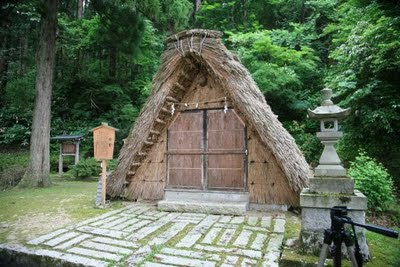
山は風のひやつく氷室哉
yama wa kaze no hiyatsuku himuro kana
the wind in the mountain
is getting so cold -
ice storehouse
Masaoka Shiki 正岡子規
*****************************
Related words
***** saffron cod 氷魚 (ひお) hio, lit. "ice fish"
..... hiuo ひうお
Eleginus gracilis
kigo for all winter
. . . CLICK here for Photos !
also called KANKAI カンカイ(寒海)
also called KOMAI 氷下魚 (こまい)
komai tsuri 氷下魚釣り(こまいつり)fishing for saffron cod
komaijiru 氷下魚汁(こまいじる)soup with saffron cod
hoshi komai 乾氷下魚(ほしこまい)dried saffron cod
:::::::::::::::::::::::::::::::::::::::::::::::::::::::::::::::::::::::::::::::::::::::::::::::::::
***** Check the WKD LIST of
. HUMANITY and All Winter Kigo
:::::::::::::::::::::::::::::::::::::::::::::::::::::::::::::::::::::::::::::::::::::::::::::::::::


